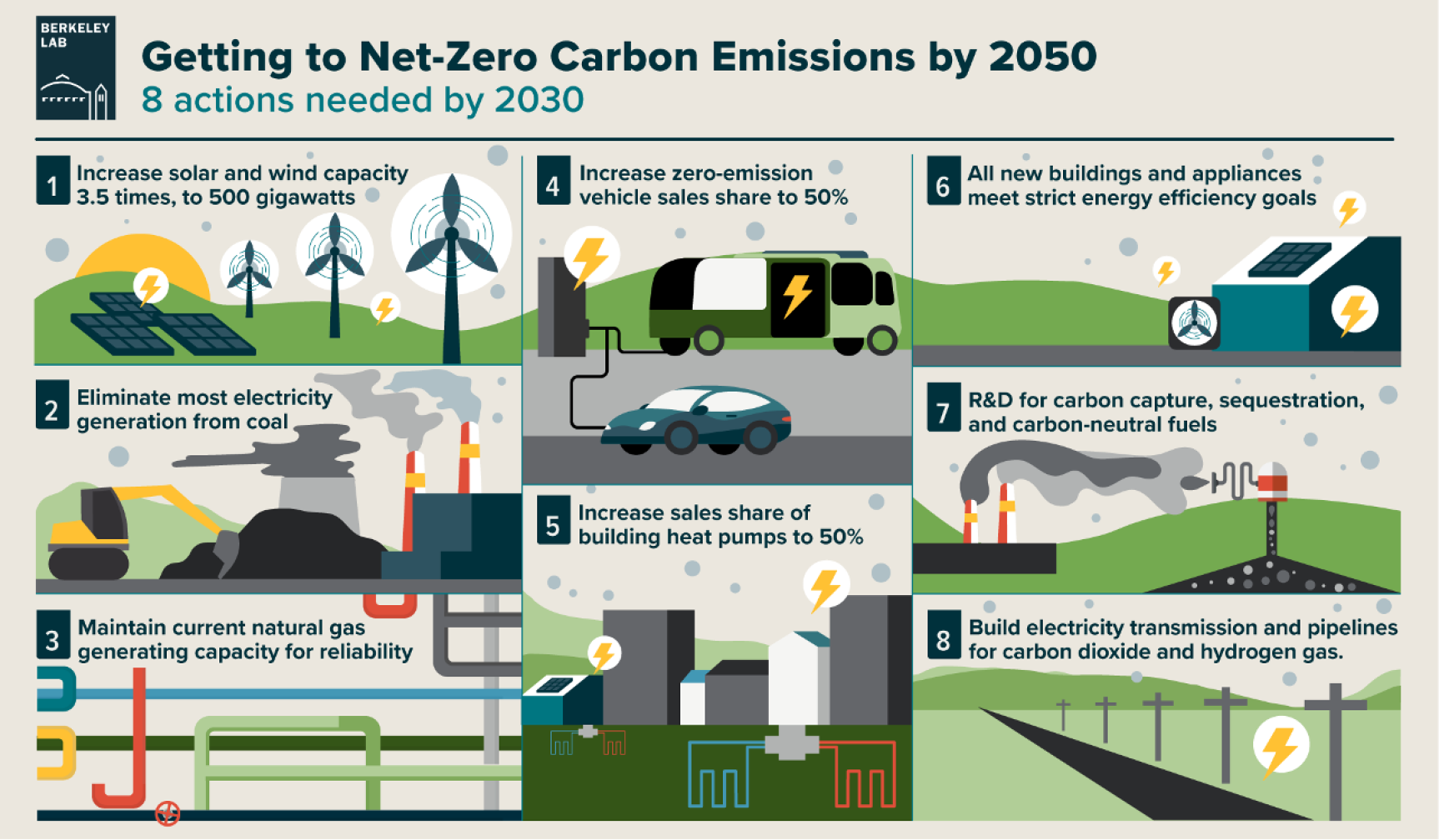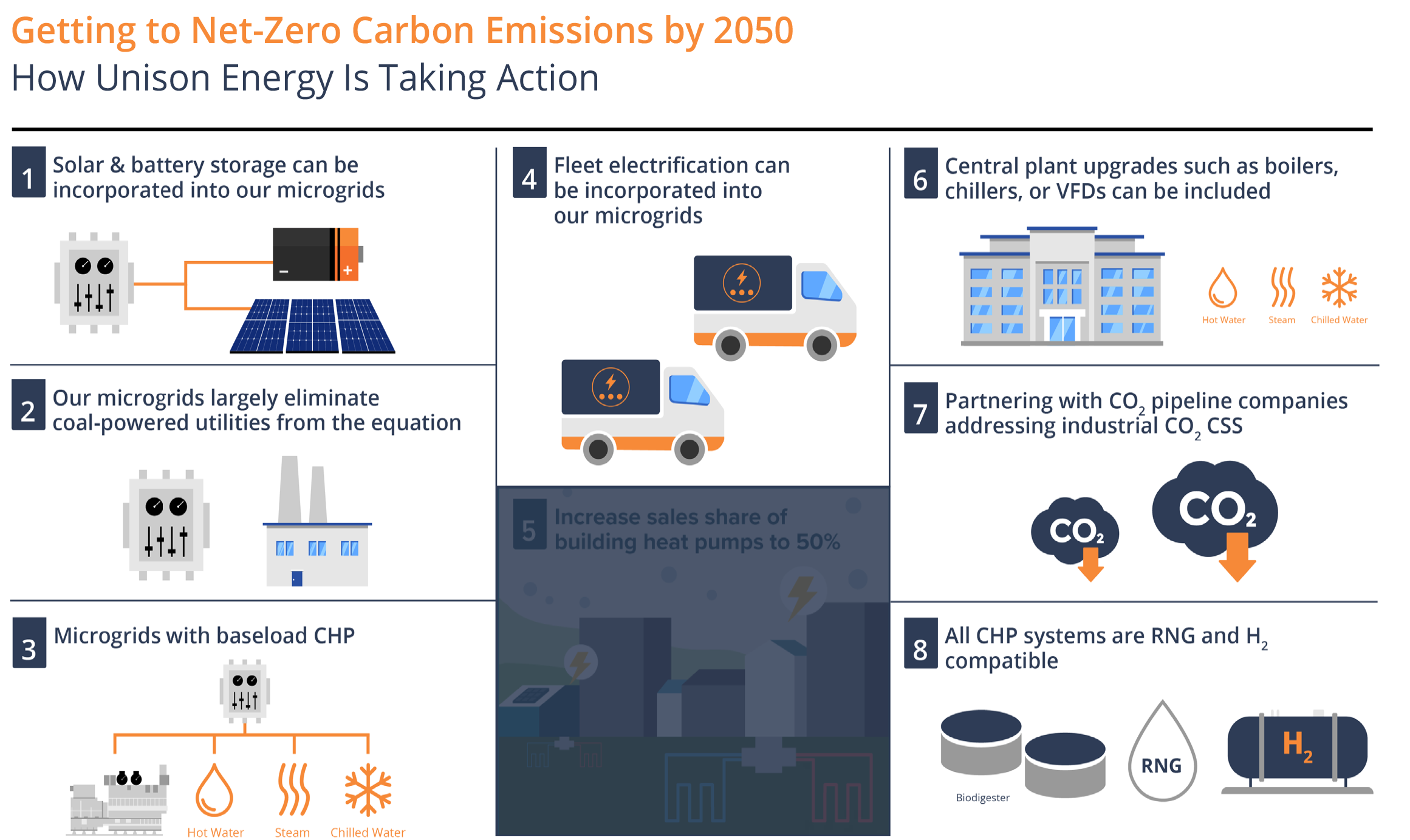Seven Steps to Net Zero by 2050

The next ten years are critical for lowering carbon emissions. New research outlines the key steps for reaching net zero, from solar and EVs to efficiency and carbon capture.
The Department of Energy has suggested these actionable steps that society must take in the next ten years. Here’s how Unison Energy helps our clients follow these steps.
To keep global warming limited to 1.5oC, the IPCC states that society must achieve carbon neutrality by 2050. The U.S. faces a major challenge over the next 30 years, and we must all look for opportunities to lower carbon emissions.
New research suggests the specific, actionable steps the U.S. must take to reach net zero by mid-century. This research is published by the Department of Energy’s Lawrence Berkeley National Laboratory, a world-class scientific research facility, along with the consulting firm Evolved Energy Research.
These are the necessary steps needed as a whole across the U.S. over the next ten years:
Take the lead on energy strategy — don’t wait for the utilities to act. Unison Energy’s on-site microgrids align with and support seven of these steps, so our clients can join the Energy Transition and be part of the solution.
Increase solar and wind capacity 3.5x to 500 GW
We can incorporate solar and battery storage into our microgrids
When space allows, on-site solar panels and battery storage can be a valuable step to sustainability for some facilities — they do not produce emissions, and a typical array can reduce carbon footprint by about 10-20%. Solar makes the largest impact on emissions during the daytime usage peak when grid utilities run marginal generators, which are more polluting.
Eliminate coal-powered electricity generation as much as possible
Our microgrids largely eliminate coal-powered utilities from the equation
As the utilities work to transition off coal, our on-site generation allows facilities to largely eliminate their usage of utility power. Our microgrids provide baseload power year-round, not just when the grid goes down. On average, utility power plants are about 38% efficient — and transmission and distribution cause additional losses. In contrast, on-site cogeneration offers up to 80% system efficiency.
Maintain current natural gas generating capacity to ensure reliable power
We offer microgrids with baseload CHP typically powered by natural gas (with the ability to transition to hydrogen and RNG as they become available)
At a utility level, natural gas plants are highly dispatchable and reliable, and aren’t going away anytime soon. An on-site cogeneration system uses natural gas to ensure resilient energy while cutting a facility’s emissions by 30-40%. These carbon savings are possible because cogeneration produces both electricity and thermal energy, providing the facility with hot water or steam and allowing them to reduce boiler usage.
Increase the sale of EVs to 50% of the market
Fleet electrification can be incorporated into our microgrids
Facilities that make the switch to EVs need a plan for supporting the increased electric load and related electrical infrastructure needed for charging. Fleet EV charging requires large amounts of reliable energy during specific charging windows, which the grid may be unable to support. We can provide EV fleet charging infrastructure for facilities as part of our microgrid implementation, ensuring reliable, cost-effective power. As part of the Energy Services Agreement, we can also incorporate EV charging stations. Finally, Unison can help facilities leverage the financial incentives for EVs in the Inflation Reduction Act.
Apply strict energy efficiency goals to all new buildings and appliances
Central plant upgrades such as boilers, chillers, LEDS, or VFDs can be included
Many facilities have outdated equipment that requires costly maintenance and repairs. If you’re already planning a microgrid project, then you have the opportunity to upgrade your equipment at the same time, potentially replacing it with much more efficient options. We regularly handle central plant and other equipment upgrades, such as boiler replacements, new VFDs, chiller expansions, and lighting upgrades — all on our balance sheet, so you avoid upfront costs for these updates.
Support R&D for carbon capture, sequestration, and carbon-neutral fuels
We have partnered with CO2 pipeline companies to address industrial CO2 CCS
Carbon capture and sequestration (CCS) is a viable solution for facilities aiming to reach zero carbon. CCS solutions help tackle hard-to-address industrial emissions, with solutions for gas-powered CHP and facility boilers. Note that the Inflation Reduction Act extends and increases the value of the Section 45Q tax credits for CCS projects, providing a feasible path to full decarbonization for industrial and manufacturing facilities.
Build electricity transmission and pipelines for CO2 and hydrogen gas
All of our CHP systems are RNG and H2 compatible
Renewable natural gas (RNG) and hydrogen can be mixed with natural gas to lower carbon intensity. Across the U.S., many natural gas companies already inject RNG into their pipelines. Alternatively, many of our clients can incorporate a digester to produce biogas on site and directly use it to produce electricity.
The Time to Act Is Now
The Berkeley Laboratory study states that the next ten years are the time to act — and the recent Inflation Reduction Act (IRA) opens up new opportunities for action. The IRA offers a range of financial incentives that support microgrid development, carbon capture, biofuels, EV vehicles, and more, all with a time-limited window of opportunity. Unison Energy can help your facility make the most of these tax incentives and take control of your energy future.
To learn how Unison Energy can help your facility cut emissions and achieve energy independence, get in touch.
Energy insights, delivered
Subscribe for more content.


